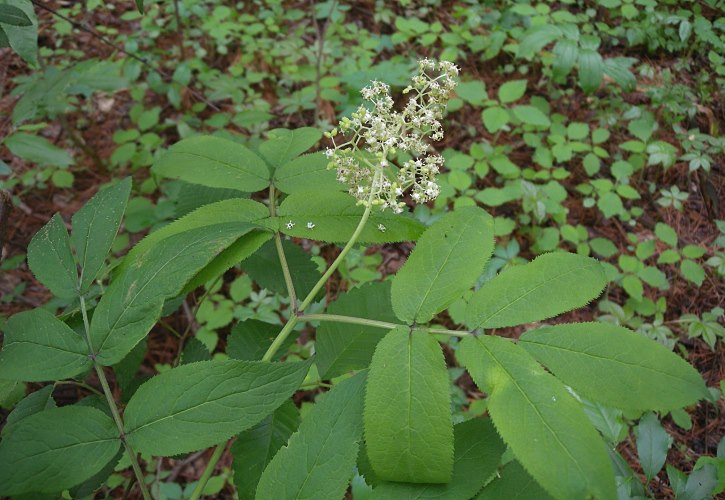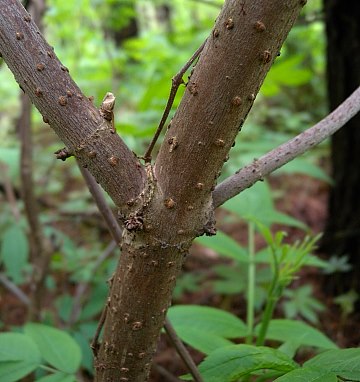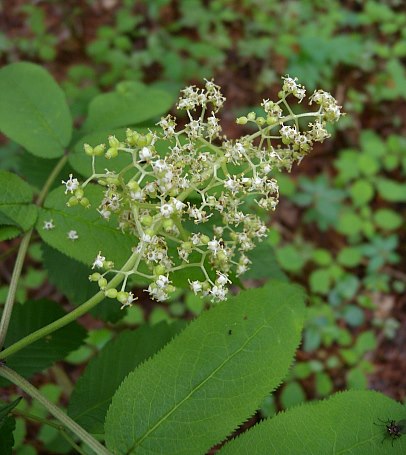Description: This shrub is 4-18' tall, branching occasionally. The base of a mature shrub is woody with reddish brown bark and small white lenticels. Young branches are light green to reddish green, and more or less terete; they are initially sparsely to moderately pubescent, but become glabrous with age. The large spongy pith of the branches is brown. Opposite compound leaves occur along young branches; these leaves are 6-14" long and odd-pinnate with 5 or 7 leaflets. The petiole and rachis (central stalk) of the compound leaf are light green to reddish green and sparsely to moderately pubescent. Individual leaflets are 2-4" long and 1-2" across; they are oblong-lanceolate to oblong-ovate in shape and serrated along their margins. The upper surface of the leaflets is medium to dark green and glabrous, while the lower surface is pale green and glabrous to sparsely pubescent. Usually there is some pubescent along the central vein on the lower side. The petiolules (petioles at the bases of the leaflets) are light green to purple and short.

Occasionally, panicles of whitish flowers are produced from axils of the upper leaves or the upper stems. Individual panicles are 2-4" long and 1½-2½" across; their peduncles (basal stalks) are 2-4" long. Each panicle is intricately branched with the flowers occurring in groups of 2-3; the pedicels are light green and finely pubescent. Individual flowers are about 1/8" (3 mm.) across, consisting of a short tubular calyx that is light green with 5 deciduous lobes, a greenish white to white or cream-colored corolla with 5 strongly recurved petaloid lobes, 5 spreading stamens with white filaments and pale yellow anthers, and a pistil with 3 small stigmata. At the bud stage, the flowers are sometimes pinkish. The blooming period occurs from mid- to late spring and lasts about 3 weeks. The flowers have an unpleasant fragrance. During the late spring to mid-summer, the flowers are replaced by fleshy berries. Mature berries are about 1/8-1/6" (3-4 mm.) across, globoid to subgloboid in shape, and bright red with a juicy interior. Each berry has about 3 seeds. The root system forms clonal offsets from rhizomes.
Cultivation: The preference is full sun to light shade, moist to mesic conditions, and soil containing sandy loam, silty loam, or rocky material. Where summer weather is hot, some protection from the afternoon sun is desirable.

Range & Habitat: Red Elderberry is rare in Illinois and it is state-listed as 'threatened.' Outside of cultivation, it is found only in the NE section of the state (see Distribution Map). This shrub is more common in boreal areas that lie to the north and northeast of Illinois. In Illinois, habitats include moist to mesic open woodlands and forested bogs. In these habitats, canopy trees are sometimes deciduous and sometimes coniferous. Outside of Illinois, this shrub has been found in upland rocky woodlands, wooded slopes with a northern exposure, swamps, and sandy meadows.
Faunal Associations: Only pollen is offered as a reward to visitors of the malodorous flowers. Observerations of insects visiting the flowers of this shrub include the honeybee, an Andrenid bee (Andrena vicina), a flower fly (Syrphus ribesii), long-horned beetles (Cerambycidae), and other beetles (Lovell, 1900; Lovell, 1915; Gosling, 1986). Other small bees and flies probably visit the flowers too. Other insects feed destructively on various parts of Red Elderberry. They include larvae of the Elder Bud Midge (Asphondylia sambuci), larvae of the Elder Flower Midge (Schizomyia umbellicola), and larvae of a sawfly (Macrophya albomaculata). Some polyphagous insects probably feed on this shrub too (Aldrich & Osten-Sacken, 1905; Felt, 1917; Smith, 2016). Several species of birds feed on the fruits of Red Elderberry, including the Ruffed Grouse, Rose-breasted Grosbeak, Northern Catbird, Northern Flicker, Red-headed Woodpecker, Veery, Swainson's Thrush, and Alder Flycatcher. Many of these birds also use this shrub for protective cover (see Bird Table for more complete information). Among mammals, the White-footed Mouse and Woodland Deer Mouse reportedly eat the fruits and/or seeds, and the American Black Bear also eats the fruits (Hamilton, 1941; Noyce & Coy, 1990).

Photographic Location: A sandy woodland that was dominated by pine trees in NW Ohio.
Comments: Red Elderberry is cultivated primarily for its attractive red berries. These berries are slightly toxic to humans, but after cooking they can be used to make jelly or wine. The eastern North American variety of this shrub has been referred to as Sambucus racemosa pubens (also Sambucus pubens); it differs from the typical European variety by its pubescent stems, leaves, and pedicels. Other authorities refer to eastern North American shrubs of this species as Sambucus racemosa racemosa. There is also a western North American variety with black berries. The only other species of this genus in Illinois, Sambucus canadensis (Common Elderberry), is more common and distributed throughout the state. Unlike Red Elderberry in eastern North America, Common Elderberry produces black berries and its panicles of white flowers are wide and rather flat-headed. An unrelated species, Aralia racemosa (Spikenard), superficially resembles Red Elderberry, but it has small umbellets of 5 or more flowers within each panicle, its berries are dark purple, and it is non-woody.